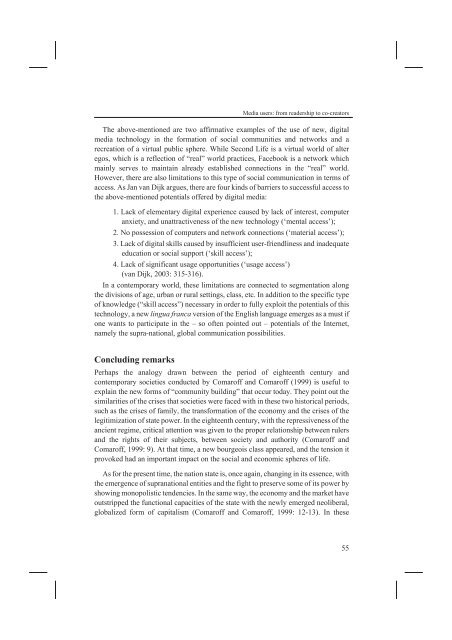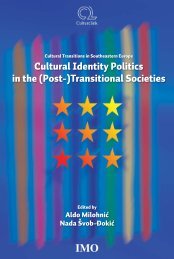D:\Documents and Settings\Ana\My Documents\Biserka-knjiga ...
D:\Documents and Settings\Ana\My Documents\Biserka-knjiga ...
D:\Documents and Settings\Ana\My Documents\Biserka-knjiga ...
Create successful ePaper yourself
Turn your PDF publications into a flip-book with our unique Google optimized e-Paper software.
The above-mentioned are two affirmative examples of the use of new, digital<br />
media technology in the formation of social communities <strong>and</strong> networks <strong>and</strong> a<br />
recreation of a virtual public sphere. While Second Life is a virtual world of alter<br />
egos, which is a reflection of “real” world practices, Facebook is a network which<br />
mainly serves to maintain already established connections in the “real” world.<br />
However, there are also limitations to this type of social communication in terms of<br />
access. As Jan van Dijk argues, there are four kinds of barriers to successful access to<br />
the above-mentioned potentials offered by digital media:<br />
1. Lack of elementary digital experience caused by lack of interest, computer<br />
anxiety, <strong>and</strong> unattractiveness of the new technology (‘mental access’);<br />
2. No possession of computers <strong>and</strong> network connections (‘material access’);<br />
3. Lack of digital skills caused by insufficient user-friendliness <strong>and</strong> inadequate<br />
education or social support (‘skill access’);<br />
4. Lack of significant usage opportunities (‘usage access’)<br />
(van Dijk, 2003: 315-316).<br />
In a contemporary world, these limitations are connected to segmentation along<br />
the divisions of age, urban or rural settings, class, etc. In addition to the specific type<br />
of knowledge (“skill access”) necessary in order to fully exploit the potentials of this<br />
technology, a new lingua franca version of the English language emerges as a must if<br />
one wants to participate in the – so often pointed out – potentials of the Internet,<br />
namely the supra-national, global communication possibilities.<br />
Concluding remarks<br />
Media users: from readership to co-creators<br />
Perhaps the analogy drawn between the period of eighteenth century <strong>and</strong><br />
contemporary societies conducted by Comaroff <strong>and</strong> Comaroff (1999) is useful to<br />
explain the new forms of “community building” that occur today. They point out the<br />
similarities of the crises that societies were faced with in these two historical periods,<br />
such as the crises of family, the transformation of the economy <strong>and</strong> the crises of the<br />
legitimization of state power. In the eighteenth century, with the repressiveness of the<br />
ancient regime, critical attention was given to the proper relationship between rulers<br />
<strong>and</strong> the rights of their subjects, between society <strong>and</strong> authority (Comaroff <strong>and</strong><br />
Comaroff, 1999: 9). At that time, a new bourgeois class appeared, <strong>and</strong> the tension it<br />
provoked had an important impact on the social <strong>and</strong> economic spheres of life.<br />
As for the present time, the nation state is, once again, changing in its essence, with<br />
the emergence of supranational entities <strong>and</strong> the fight to preserve some of its power by<br />
showing monopolistic tendencies. In the same way, the economy <strong>and</strong> the market have<br />
outstripped the functional capacities of the state with the newly emerged neoliberal,<br />
globalized form of capitalism (Comaroff <strong>and</strong> Comaroff, 1999: 12-13). In these<br />
55



